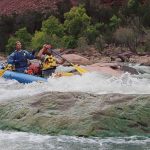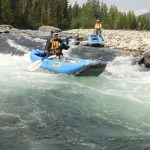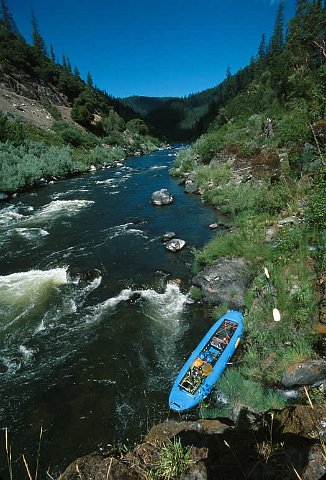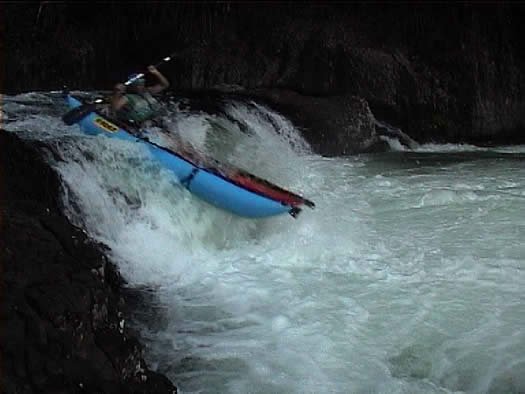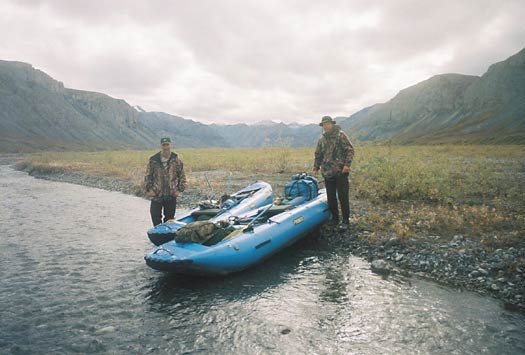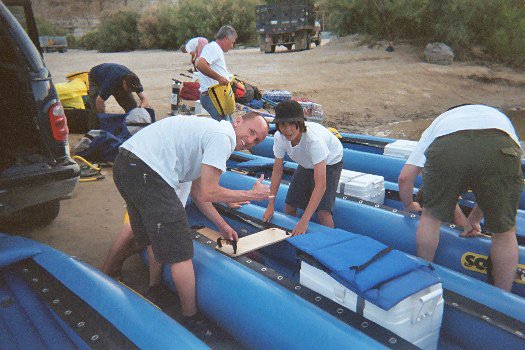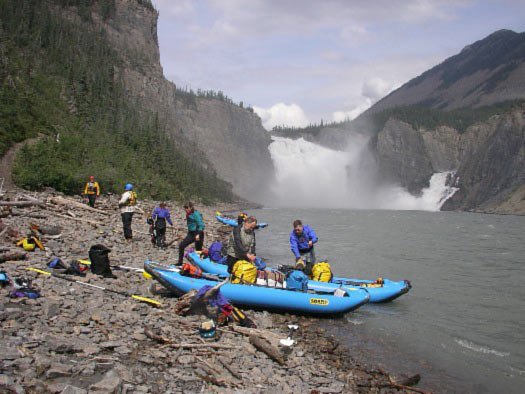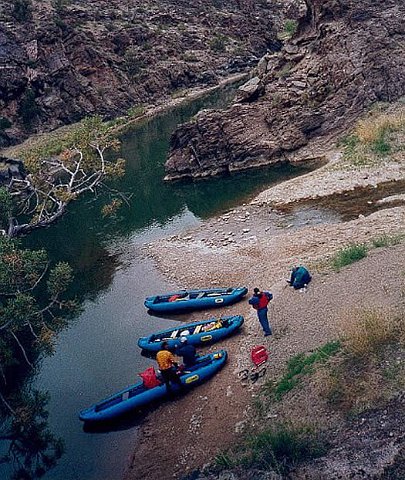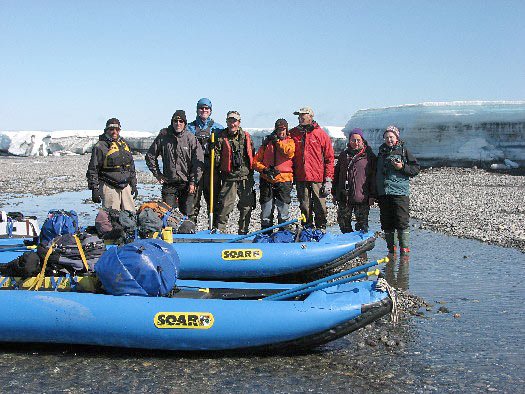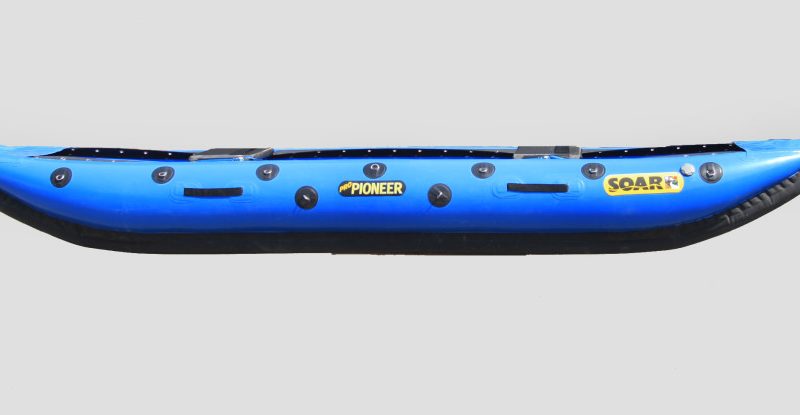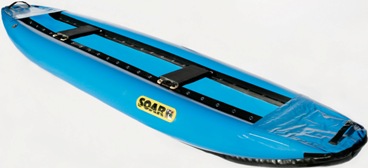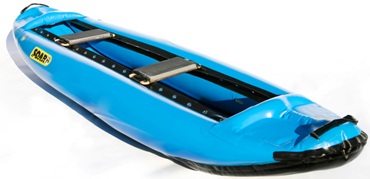KLAMATH RIVER NAVIGATION
This spring of 2002, I endeavored to travel the true length of the great Klamath River. The idea is easy, although few might attempt it, no-one had within historical knowledge. The River is embattled and in bitter dispute, conflicting philosophies and activities continue, whatever the case, our “western” actions have truly threatened the very fabric of its fertility. The previous year (2001) had seen great political and cultural turmoil, a recision of certain water rights to upper basin irrigated agriculturalists, in purported favor of a few relatively unknown and elusive aquatic fish species, apparently catalyzed the debate. Tribulation and conflict followed, covered in remarkable fashion by the mainstream media; instantaneously the remote and valuable Klamath River became a matter of public debate, a decision to be decided particularly by those who probably had the least direct knowledge of the nature of this waterway.
I endeavored this journey to document the condition of the river corridor, this attempt was two fold in conception: 1) To document the natural systems of this river artery and 2) to document those alterations and impairments which affect the functioning and natural systems of the river system.
This was not my first effort within the Klamath, I feel I can state a certain dedication to the region, it is this personal history which precipitated this effort. A feeling of obligation had set in, through personally & professional directed exposure to the grandeur of the Mountains, and its drainage’s, over the last decade and some.
This respect I have gained, has become deepened by a growing appreciation & gratitude for the native inhabitants of the watershed. As a group they were a settled people, who had deep abiding allegiance to the region, which in turn, spawned the very culture, which to a great extent, have been suppressed into vanishment and desperation.
As it unfortunately happened, the following fall of my spring navigation, there occurred in the lower Klamath corridor a spiritually and biologically catastrophic event… The loss of life of a great migration of adult returning salmonids. The number is gruesome, it cheapens the loss of life to number it.
If for every minute of everyday you lamented the loss of life a single salmon, it would require a penitence of nearly a full lunar cycle… But penitence alone will not solve the tangible and philosophical roots of this injudicious alteration and mismanagement of the regions natural legacy.
So it was that this spring I endeavored to plan the trip down the river; a 400 mile venture is however not easily accomplished, and requires a certain level of planning to accomplish. One of the most important aspects required in order to bring this idea into reality became the availability of a craft which would successfully aid in my attempt. No simple boat however would suffice, and without a sufficient craft, this journey was without hope. As limited funds are seemingly a prerequisite of many a high integrity voyage, I set out to find both the craft, and the manufacturer who would sponsor such an outlandish mission. SOAR (somewhere on a river), it now turns out, was the correct and most beneficent sponsor of this excursion to solicit. SOAR whole heartedly engaged my visionary spirit, supplying both craft and many implements, which were essential in facilitating my journey down the length of maybe the last great river of the western U.S..
It may be mentioned that only two great rivers transgress the Cascades of the Western United States, these are the Columbia and the Klamath. The Columbia was first traveled by the Lewis and Clark party, as part of their investigation of the routes to the pacific ocean, under President Jefferson (potentially anticipating the Louisiana Purchase), they hoped a waterway would lead them from east of the rockies to the pacific, such a route could not be found, such a river had no real existence… They were working in part based upon cultural mythology. Were it not for the assistance of Native Americans of diverse tribes, there attempt would be lost to archeological record, and attested a failure. If by chance along my path to the ocean I had failed in death, it would have been attested a vain mistake of questionable validity…. However, I had both some skill and knowledge, and a specific craft worthy of the mission, this a SOAR-14 Inflatable Kayak, the most fundamental tool allowing for my attempt, now accomplished.
KEY CHARACTERISTICS OF THE SOAR-14 INFLATABLE KAYAK
* The inflatability & deflatability of the SOAR-14 is a critical characteristic. For the Klamath River Navigation, it was required on a number of occasions, to portage sections of the most constricted unrunnable sections, as well as to portage around dams and other human constructs. In preparation for these occasions, I had brought an external frame pack, upon which I was able to affix my gear, including the deflated SOAR-14, and travel by foot around such features (in general it took 3 portage trips for each particular obstacle encountered). Also for shipping and transport, the boat rolls up efficiently, and stores well, which also is an important attribute.
* The “Self-Bailing” ability of the SOAR Inflatable Kayaks, is also and obviously critical. I found the floor to be excellent, and the self-bailing capability worthy. Even with approximately 100 pounds of gear and myself, the floor kept dry in flat water, and drained quickly in whitewater.
* The sturdy band of “grommets” running the length of the two top tubes, on the inside of the boat, created a perfect ability to “sew” gear to the craft with cam-straps. There is an adage in whitewater rafting, that is “rig to flip”, another adage brought on by a 30 day trip through the Grand Canyon on the Colorado, which I was lucky enough to be on was, “Gear and Ungear” (pronounced geara unt geara). The ability to store gear in the inside of the boat, and affix it to the craft with the aid of these dual grommet bands, was essential in my day to day existence as I lived from this boat. How important of a fact, and yet easily overlooked, for 40 days I lived on and from the boat as I traveled by river from the headwaters to the ocean, and my gear was transported with me, safely strapped into the SOAR-14.
* The material workmanship and strength of SOAR Inflatable Kayaks was required and put to the test on many occasions. It should be mentioned, that the SOAR S series crafts are built just as professional / commercial whitewater rafts are. This strength and durability was critical, though I was supplied with a professional patch kit, in the advent of puncture or tear, none such occurred. At many times I marveled at the resilience of the craft, particularly when pushed full force into angular rocks, or at those times when it was necessary to drag the boat over, or “line” the boat fully loaded through angular sieves and constrictions in the channel. At the end of each day, it is also necessary to pull the boat up and out of the water, both the bottom of the boat, as well as the hand holds, held up under rigorous use. I felt at times badly at my mistreatment of the craft, and yet in the end, the boat remained in remarkably good condition, ready for many more trips over years of use. In the end I feel that with such a well made boat, you can be a bit rugged with your expectation of its capabilities, because it will hold up to tough use. The durability of the SOAR S series boats ensures long life, and even more importantly, trustworthiness through even the most difficult and challenging river environments. This boat did not let me down, and I believe now, is capable of even the most treacherous river environments, let alone the general circumstances many of us find ourselves in while on the river.
* The comfort and maneuverability of the SOAR-14 should also be commended. Many long hours of each and every day, I paddled and navigated the boat down the river, and as I gained the “feel”, felt incredibly in command of this loaded down and heavy boat. Furthermore, my gearing, and the configuration of the boat, allowed me to change paddling positions, and stand up stabily, allowing me to both stretch out, and scout upcoming features with the aided visibility of being 6 feet above water line.
* Finally there is a certain aesthetic bond which I attach to things exceedingly functional, and therefore beautiful. On so many occasions, I felt a sense of privilege, to be taking such a worthy craft down the river, and looking upon it, a sense of thrill at the undertaking and its experiences. Many times I met individuals who doubted my success, or failed to understand its implications, but at those times, they would look upon this boat, myself and the gear, and their understanding would grow respectably. At last, this bond and this attraction I felt for the craft and its ability, created a sense of purpose and facilitated my motivation to continue. When you boat instills trust and confidence, its tangible purposes are then the more complimented and effective.

